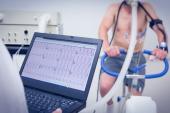Best Exercise for Heart Health? Some Hints of Intensity’s Role
The Generation 100 study included an older, but healthy, active control group, making it tough to improve CVD risk factors.

There were some encouraging signals, however, particularly among those who adhered to structured high-intensity interval training (HIIT).
“The main findings, which were surprising to us, were that we weren’t able to detect any between-group differences in the clustered cardiovascular risk score at 5 years,” lead author Jon Magne Letnes, MD, PhD (Norwegian University of Science and Technology/St. Olav’s University Hospital, Trondheim), told TCTMD. “The same was also true for most of the individual cardiovascular risk factors. Although, it’s also notable that we just barely missed the sharpened significance threshold with high-intensity interval training on the clustered cardiovascular risk score.”
Additionally, peak VO2 was significantly improved among adults who engaged in HIIT compared with those who followed the exercise guidelines. Cardiorespiratory fitness, said Letnes, is one of the most powerful markers of prognosis in terms of all-cause and cardiovascular mortality. “If you put the finding of higher VO2 peak into context with our main paper where we saw quite strong trends toward a lower mortality risk with high-intensity interval training, those findings point in the same direction,” he said.
The new Generation 100 substudy, published last month in the European Heart Journal, reports the effects of exercise training on the cardiovascular risk profile of the 1,567 adults aged 70 to 77 years from Trondheim, Norway, and follows the main results published last year in the BMJ. There, investigators reported that a structured exercise program—one that included either moderate-intensity continuous exercise or HIIT—did not significantly reduce the risk of death compared with adherence to the national exercise recommendations from health authorities.
Aaron Baggish, MD (Brigham and Women’s Hospital, Boston), who wasn’t involved in Generation 100, said he was pleased to see the follow-up study on cardiovascular risk factors as opposed to the main study results that focused on all-cause mortality.
“One of the key messages is that although exercise probably does increase how long somebody lives, what it does, for the most part, is increase how well someone lives,” Baggish told TCTMD. “It’s health spans as opposed to life spans. Health span is how long someone lives without chronic disease that disables them. We know that that the fitter you are, the more activity you get, the better your quality of life. That’s the right rationale to have done this follow-up study.”
He stressed, however, that it’s important not take the wrong message away from the substudy. Any conclusion that supervised exercise had no effect on heart health needs to be tempered, because the control population in Generation 100 were older, northern Europeans who met physical activity recommendations.
“This is a population where, according to the Norwegian physical activity guidelines, they are getting 30 minutes or aerobic activity most days of the week,” said Baggish. “You’re comparing people who are doing some sort of structured exercise with people who are probably getting the equivalent amount of physical activity without structure. To make a claim that exercise doesn’t improve cardiovascular risk factors when you’re comparing them to people who are getting a fair bit of exercise? It’s probably destined to be a null result out of the gate.”
Generation 100 Study
In the Generation 100 study, the control group was asked to follow the Norwegian Health Authority’s recommendation to do approximately 30 minutes of moderate-intensity physical activity most days but received no further supervision. Those randomized to moderate-intensity continuous exercise (approximately 70% of peak heart rate) were required to complete 50 minutes of continuous exercise two times per week. With HIIT, adults performed two sessions of 4 x 4-minute intervals each week (approximately 90% of peak heart rate). Every 6 weeks, those in the structured programs met with an exercise physiologist to exercise with heart rate monitors to ensure they were working at the correct intensity.
“We know from a lot of shorter-term studies, and mostly in younger subjects, that high-intensity interval training has proven to be quite time efficient in improving some of these cardiovascular risk factors and also measures of cardiorespiratory fitness,” said Letnes. “Our main objective was to examine these effects in older adults and over a longer time span.”
In the analysis combining both structured programs, there was no significant improvement in the clustered cardiovascular risk score, individual risk factors, or peak VO2 when compared with the control group who followed the national exercise recommendations. Analyzed separately, there was a trend toward an improvement in the clustered cardiovascular risk score with HIIT compared with the control group. Those randomized to HIIT had a significantly higher peak VO2 compared with the control group (0.76 mL/kg/min; P < 0.01), but there was no significant difference in peak VO2 between the HIIT group and those who performed moderate-intensity continuous training.
On the whole, the study shows that exercise is an extremely safe intervention for older adults, including those who participate in HIIT, noting they observed no serious adverse events and even saw signs of benefit, Letnes said. “That should be very encouraging and reassuring for older adults who want to do this type of exercise.”
For Baggish, the study suggests that the intensity of exercise—either HIIT or moderate-intensity continuous—doesn’t appear to have a major impact on cardiovascular risk factors, such as blood pressure, cholesterol levels, or glucose metabolism. “There doesn’t seem to be much of a signal around intensity,” he said, “but that doesn’t necessarily mean that these [risk factors] weren’t keeping people healthy and keeping them in better shape than people who don’t get physical activity, which is really the big control group we wonder about.”
Intensity, on the other hand, did have a positive impact on body mass index, which was significantly lower with HIIT compared with the control group and the moderate-intensity exercisers, and cardiorespiratory fitness.
“That’s important because the fitter you are, the more you can do, and typically the better you feel doing it,” said Baggish. “I think it’s probably a good news story for HIIT, but it also provides people with an opportunity to do non-HIIT, sustained moderate-intensity work if that’s what they’d prefer. For most of the things that determine heart health, there doesn’t appear to be much difference.”
Halting Biological Decline
Like Baggish, Letnes said the Norwegian subjects enrolled in the study differed from those enrolled in other studies, and that this might explain their results.
“We know that the people who participated were healthier compared with a large cohort of patients in the HUNT study, which is a large epidemiological study in a neighboring county,” he said. “They had lower blood pressure and body mass index, for example, than the general population. It’s a very healthy sample. I think our findings should be interpreted with caution because when you have such a healthy population, it’s hard to improve these cardiovascular risk factors even further. Had we recruited a less-healthy patient population, the results might have been somewhat different, although that’s just speculation.”
Importantly, Letnes said that while patients who performed HIIT had significantly higher peak VO2 compared with the control group, all subjects benefited from the intervention. With this age group, studies have suggested VO2 peak declines by 20% over 10 years, which would translate into an expected decline of 10% in their 5-year study. Exercise, whether it’s HIIT, moderate-intensity continuous training, or simply adhering to the national guidelines, countered such a decline.
“When you see the VO2 peak data from this study, it’s quite remarkable that after 5 years, they were still at the same level as they were at baseline, although the HIIT group was higher than the others,” said Letnes. “That means that they have halted their biological age by 5 years during the course of this study. The trends that we’re seeing in VO2 peak are quite remarkable. You can actually halt this effect of aging quite a bit.”
Michael O’Riordan is the Managing Editor for TCTMD. He completed his undergraduate degrees at Queen’s University in Kingston, ON, and…
Read Full BioSources
Letnes JM, Berglund I, Johnson KE, et al. Effect of 5 years of exercise training on the cardiovascular risk profile of older adults: the Generation 100 randomized trial. Eur Heart J. 2021;Epub ahead of print.
Disclosures
- Letnes and Baggish report no relevant conflicts of interest.





Comments